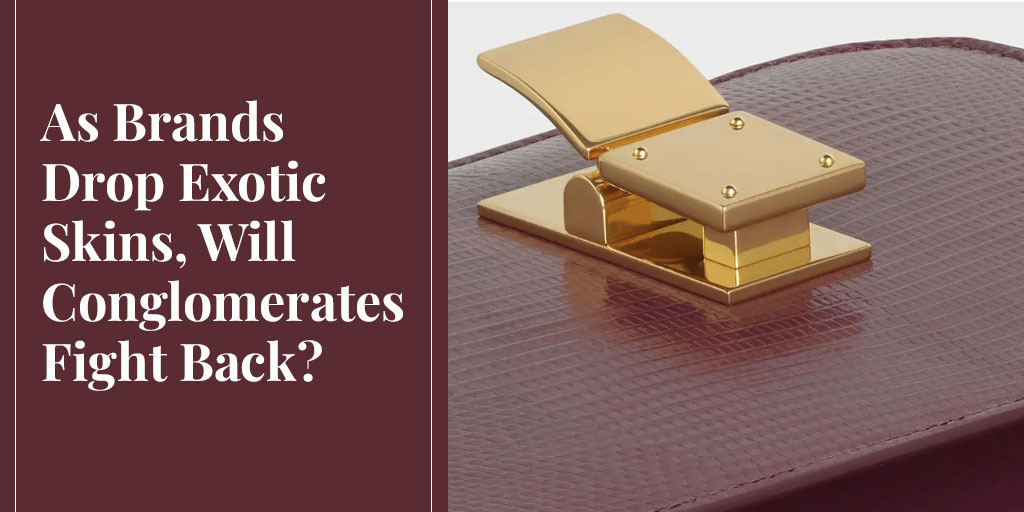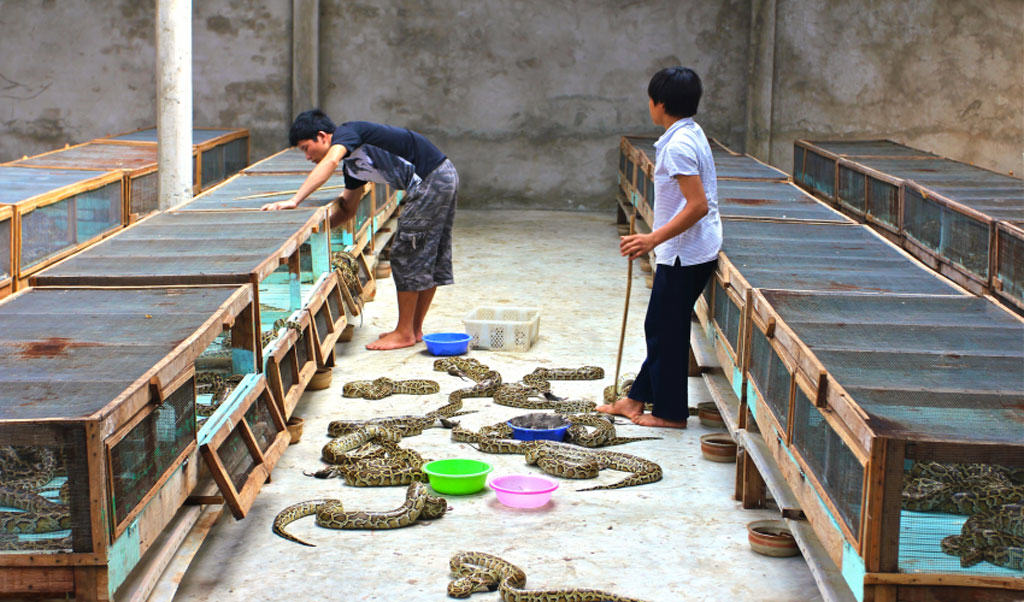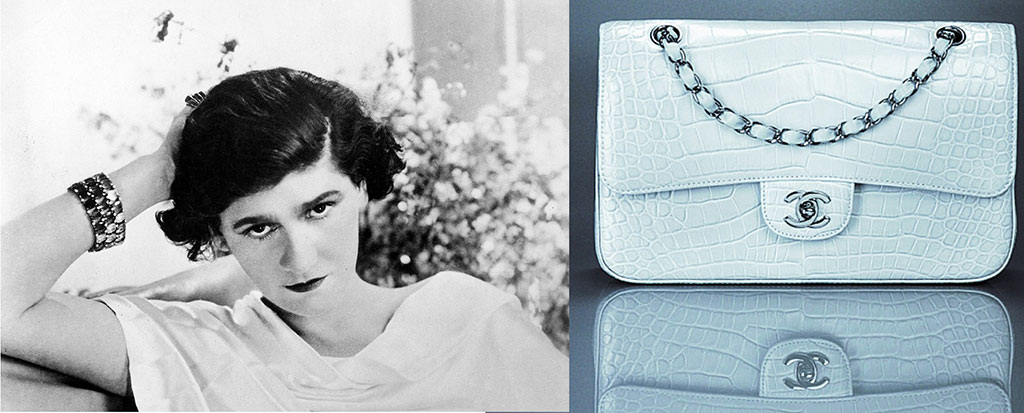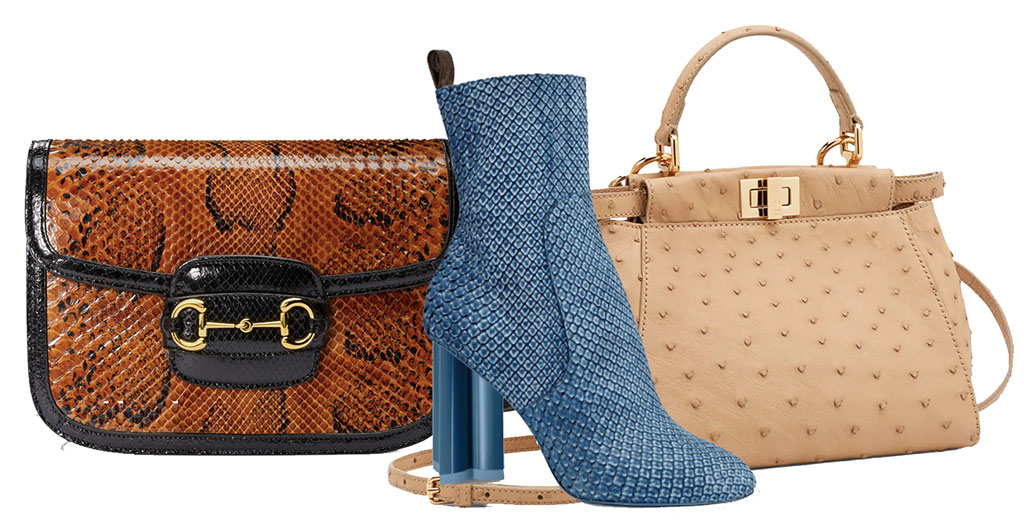
I hate to say “I told you so!” but only a fool could not have seen this coming. A few short years ago, while clearly being manipulated by animal rights groups, a wave of designer brands very publicly announced they would be dropping fur. Inevitably, they are now being pressured to drop exotic skins too, and many are capitulating. After all, how can fur be bad, but exotic skins ok? The question now is: how much of their core business are the big luxury conglomerates ready to sacrifice on the altar of political correctness?
Indeed, all the arguments for and against fur and exotic skins are essentially the same. On the one hand, both are beautiful natural materials, and if produced responsibly, they’re renewable and sustainable, leaving a negligible environmental footprint. On the other hand, both involve the taking of life, which animal rights groups oppose on principle and work hard to present as cruel. For a contemporary twist, those same groups now also claim that trading in furs and exotic skins increases the risk of pandemics like Covid-19.
Yet this time around, advocates of sustainable use are hoping for some stiffer resistance, and specifically from two of the world’s largest luxury goods conglomerates, LVMH and Kering. Not only do their corporate policies strongly endorse sustainability, but they are also invested in their supply chains for exotic skins. It seems unlikely they will abandon these investments without a fight.
SEE ALSO: Fur is a sustainable natural resource. Truth About Fur.
As a subplot to the bigger story, the fur trade should watch Kering subsidiary Gucci closely. This iconic brand rocked the fashion world in 2017 when it dropped fur in the name of “sustainability”. If it now dumps exotic skins, that would at least be consistent. But if it toes the Kering line and sticks with exotic skins, how will it explain the double standard?
So What Are “Exotic Skins”?

But first, let’s clarify what an “exotic skin” is. It’s a loose category used by the Western fashion industry mostly for the skins of reptiles – snakes, crocodilians, and lizards. Some fish are in there too, like stingrays and sharks. And then there are ostriches. (The jury seems to be out on whether kangaroo leather is exotic or not.)
Some animals are taken in the wild – obviously stingrays and sharks – but most are now farmed, with ostrich and croc farming having long histories. As for where the skins end up, most are used for shoes, bags and belts, plus a few jackets and hats.
To put the current exodus from exotic skins in context, we need to turn the clock back just four years or so. For two decades, animal rights groups – led by PETA and HSUS – had been pressuring designers to drop fur. And then suddenly, the dominoes started to fall. Armani, Hugo Boss, Versace, Gucci, John Galliano, Burberry, Prada – the list just kept on growing.
A very few, like Donatella Versace, seemed genuinely happy to drop fur, but all were either nudged gently or prodded hard by PETA and HSUS. And when they succumbed, they usually felt compelled to make public statements against fur that inevitably made it harder for other fur-using brands to stand their ground.
And to make it harder still, animal rights groups made sure these brands got lots of press coverage and showered them with “green” points. Yes, “green”, because this mass defection from fur was not couched in animal rights terms, and only partially as animal welfare. Above all, we were told, it was about “sustainability”. In short, by ditching fur, these brands were saving the planet!
SEE ALSO: Why is Giorgio Armani really quitting fur? Truth About Fur.
Gucci’s “Sustainability” Claim Slammed

None of the new converts appeared more opportunistic — or misinformed — than Gucci, previously such a prolific user of fur. And to make matters worse, Gucci is seen as a leader in the luxury sector, so its influence on other brands and the negative press it generated for fur were tremendous.
In 2017, Gucci CEO Marco Bizzarri raised the eyebrows of anyone who understood sustainability when he announced the company’s new policy. Dropping fur, he explained, was a demonstration of “our absolute commitment to making sustainability an intrinsic part of our business.” So, bizarrely, it was goodbye to renewable, biodegradable, natural fur, and hello to non-biodegradable fake fur made from non-renewable petroleum.
SEE ALSO: Fur-free Gucci policy contradicts company’s “sustainability” claims. Truth About Fur.
As if that were not bizarre enough, conspicuous by its absence was any suggestion by Bizzarri that Gucci might drop exotic skins. His animal rights handlers were also silent on the subject, but was he really naive enough to think that would last?
In fact, for several years Gucci’s parent company, Kering, has been in a partnership with the International Union for the Conservation of Nature in a conservation and sustainable use project farming pythons. Cooperative ventures of this type are now commonplace for species in the exotic skin trade, securing supply chains while relieving pressure on wild populations, not least by reducing poaching. In short, Kering’s python farm is the epitome of sustainability.
So sooner or later Gucci will have to address a quandary of its own making. An estimated 85% of fur today comes from farms (and wild-fur harvesting is strictly regulated), but Bizzarri says the trade is unsustainable. Meanwhile, Kering supplies his company with farmed python skins. Will Gucci now defy Kering and drop exotic skins too? Or will it make the totally unsupportable claim that snake farming is sustainable but fur farming is not?
First to Fold: Chanel

First to fall among exotic skin users was independent fashion house Chanel, in 2018, and it came out of the blue. Designer Karl Lagerfeld told Women’s Wear Daily it was “a free choice” rather than “being imposed on us. We did it because it’s in the air,” implying that animal rights groups were not directly involved. It was generally assumed that Chanel’s weak supply chain for exotic skins meant it could no longer meet its needs, so it just threw in the towel.
Whatever Chanel’s motivation, it went public with the decision and PETA made a big song and dance over it, so they both got their free publicity.
And then, as in the fur exodus, others followed suit, all garnering the same free publicity and lavish praise from animal rights groups.
Since last year, the following brands have sworn off exotic skins, and there are surely others: Victoria Beckham, Jil Sander, Paul Smith, Mulberry, Vivienne Westwood, Diane von Furstenberg, SMCP (parent of Sandro, Maje, Claudie Pierlot and De Fursac), and PVH (owner of Calvin Klein and Tommy Hilfiger). Retailers Selfridges, Brooks Brothers, Topshop, and H&M won’t be stocking exotic skins anymore, and Nordstrom will phase them out by the end of 2021. And three fashion weeks so far have banned them: Melbourne, Helsinki and Stockholm.
But LVMH Calls Fur and Exotic Skins “Precious”

Yet perversely, this latest triumph of animal rights over sustainable use may be a blessing in disguise – the wakeup call the luxury industry needs to say enough is enough. Both LVMH and Kering are committed to exotic skins and fur, and while they don’t dictate what materials their subsidiaries use, they have huge influence. They also have a public voice, so if they’re ever going to make a strong stand in support of sustainable use, now is the time.
LVMH oversees such household names in fashion as Celine, Christian Dior, Fendi, Givenchy, Louis Vitton, Marc Jacobs, among many others. Kering’s stable is smaller but nonetheless impressive. In addition to Gucci, it represents names like Yves Saint Laurent, Balenciaga and Alexander McQueen.
So it was gratifying that at its virtual annual shareholders’ meeting last June, LVMH issued a strong endorsement of both exotic skins and fur.
As a shareholder, PETA emailed a question asking whether LVMH would be giving up fur and exotic skins “as of today”. Group managing director Antonio Belloni responded (at 46:28): “This is a recurring question on their part. Now, our position is that natural raw materials constitute a precious material and are at the heart of the outstanding products of our houses. Each house can decide on these materials, but must strictly comply with our code of practice pertaining to responsible sourcing of animal raw materials that sets out long-term commitments in three areas: traceability of supplies, animal welfare, and lastly the respect for local populations, the environment, and biodiversity.”
The problem is, this endorsement didn’t grab any headlines, but that just underscores the lack of media clout sustainable users have compared with animal rights groups. If LVMH had come out against exotic skins and fur, PETA and HSUS would have had the story on every front page from New York to Shanghai. Bottom line: there is a story here, and we just need to be more effective at telling it.
As animal rights groups continue to pressure luxury conglomerates to drop exotic skins and fur, the fur trade should be looking to revitalise the strategic alliance it has long had with these corporations, and demand they stand up and be counted. And if clueless Gucci continues to embrace exotic skins while rejecting fur, we should demand to know why.
***
To learn more about donating to Truth About Fur, click here.











As they say, “Get woke, go broke”. Plants, stones, everything is alive, all of creation, it is only their arrogance that gives their narrow minded opinions credence.
https://smile.amazon.com/Secret-Life-Plants-Fascinating-Emotional/dp/0060915870/ref=sr_1_1?dchild=1&keywords=the+secret+life+of+plants+peter+tompkins&qid=1601561170&s=books&sr=1-1